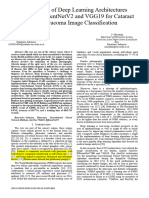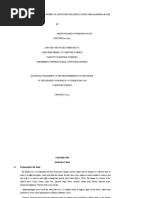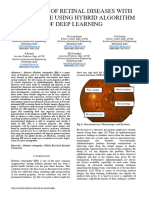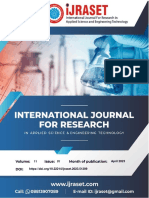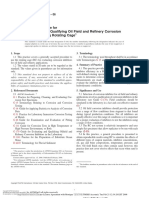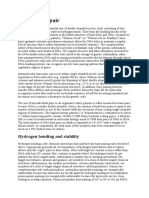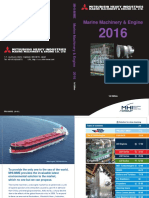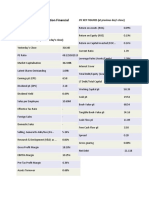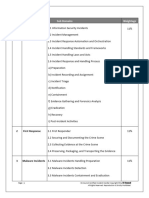EYEE
EYEE
Uploaded by
swethaCopyright:
Available Formats
EYEE
EYEE
Uploaded by
swethaOriginal Title
Copyright
Available Formats
Share this document
Did you find this document useful?
Is this content inappropriate?
Copyright:
Available Formats
EYEE
EYEE
Uploaded by
swethaCopyright:
Available Formats
EXPLORING DEEP LEARNING ARCHITECTURES FOR EYE
FUNDUS DISEASE SEGMENTATION
xxxx1 xxxxx2 xxxxx3
Department of Electronics and Department of Electronics and Department of Electronics and
Communication Engineering Communication Engineering Communication Engineering
SRM Institute of Science and SRM Institute of Science and SRM Institute of Science and
Technology, Kattankulathur, Chennai, Technology, Kattankulathur, Chennai, Technology, Kattankulathur, Chennai,
ct6803@srmist.edu.in krithigas@srmist.edu.in as9209@srmist.edu.in
identifying and delineating various structures and
pathologies within the retina, which is essential for effective
Abstract - Eye fundus disorders, such as diabetic treatment planning and monitoring disease progression.
retinopathy, glaucoma, and age-related macular Traditional methods of image analysis often fall short in
degeneration, can lead to severe vision impairment or terms of accuracy and efficiency, particularly when faced
blindness if not diagnosed promptly. Manual diagnosis is with the variability in image quality and the complex nature
time-consuming and requires expert knowledge. This of retinal anatomy.In recent years, advancements in deep
research proposes an AI-based system for classifying and learning architectures have led to significant improvements
segmenting eye fundus diseases using a large, annotated in image segmentation tasks. Techniques Convolutional
dataset of fundus images. Leveraging deep learning Neural Networks (CNNs) and U-Net and extracting features
techniques, particularly Convolutional Neural Networks and improving segmentation precision. By leveraging large
datasets and sophisticated algorithms, deep learning offers a
(CNNs), the system aims to enhance diagnostic accuracy by
promising avenue for enhancing the accuracy of eye fundus
identifying diseases and segmenting affected areas. Studies disease segmentation, ultimately contributing to better
have shown promising results, with AI models achieving patient outcomes and more efficient clinical workflows.
high accuracy, sensitivity, and specificity in detecting retinal This exploration of deep learning architectures will delve
diseases. into their design principles, strengths, and the challenges
faced in the realm of eye fundus disease segmentation,
highlighting their transformative potential in
Keywords – Eye Fundus Disease, Artificial ophthalmic diagnostics. In section [II] lets discuss about
Intelligence, Deep Learning, Disease Classification, Related work of Eye Fundus diseases.
Segmentation, Convolutional Neural Networks, U-
Net, Ophthalmology, Medical Imaging, Diagnostic II. Related Work
System.
J C Fan [1] proposes Power analysis indicated that older
adults displayed significantly lower alpha activity in the
bilateral temporal pole regions and the right parieto-
I. Introduction temporo-occipital areas compared to younger individuals,
while exhibiting increased beta and gamma wave activity
Identifying issues related to the fundus of the eye is during rest. Source analysis identified potential brain
essential for the timely detection and treatment of various regions associated with these age-related alterations.
ocular diseases, such as diabetic retinopathy, macular Furthermore, entropy analysis revealed greater wavelet
degeneration, and glaucoma. Rapid and accurate recognition complexity in the brain activity of older adults, with the
of these conditions is vital to prevent vision loss and occipito-parietal lobes recognized as the primary sources of
improve patient outcomes. Recently. These methods this activity. This finding implies that older adults may
facilitate the automated detection and classification of subtle experience elevated ongoing brain activity even while at
pathological changes that may be overlooked by human rest, possibly related to inhibitory dysfunction. Additional
experts. Furthermore, integrating AI with telemedicine research is needed to confirm this hypothesis.
offers a promising solution for screening and monitoring
major eye diseases within primary care settings. Overall, the Samira Ortiz [2] Model utilizes with pre-time compressing
utilization of AI in ophthalmology not only enhances of 1906 fundus images as a result execute the efficiency by
diagnostic accuracy but also streamlines workflows, classifying with accuracy of 97%
ultimately leading to better management of eye diseases.
Deep learning has revolutionized various fields, and medical Cheng Li [3] proposes The Dense Correlation Network
imaging is no exception. Among its applications, eye fundus (DCNet) is created to take advantage of the dense spatial
disease segmentation has increasing prevalence of ocular correlations present between paired CFPs.
diseases and the critical need for accurate diagnostics. The
retina, captured through fundus imaging, provides valuable Reyhansyah Prawira [4] proposes The research seeks to
insights into a person's overall health, revealing identify diseases in fundus images using multi-label
conditions.Segmentation of eye fundus images involves classification. This study will apply deep learning methods
with the AlexNet and VGG16 architectures, assessing their data existing system provides the doctors on ophthalmology
performance against each other. The dataset consists of optical topography reports with employees with high
1,133 fundus images related to Diabetic Retinopathy (DR), tracking data which can be done with an prediction method
Macular Edema (MA), and Optic Disc Cupping (ODC). which can able to be enhance the education of the system
Results indicate that the AlexNet model surpasses the classes is the providers with the assumed randomly reports
VGG16 model in effectively carrying out multi-label for scale and fixation. Existing system Performance is
classification on fundus images. blinded without sufficient data as it is more extensive data
collection needed to improve. Quality of data which cannot
Raji Elsa Varghese [5] The proposed system demonstrated be used for enhancing performance. Present Architecture
notable performance improvements following fine-tuning. will not able to capture OCT reports. As of CNN's based
Initially, the model achieved an accuracy of 81.00%, which Prediction it predicts the corelation effects which is limited
significantly increased to 94.74% after optimization. This to accuracy. In Section [III] describe to overcome issues by
enhanced accuracy indicates improved precision and inventing solution through proposed system.
reliability, with precision rising from 79.25% to 93.99%,
thereby reducing false positives. Recall also improved, IV. Proposed System
increasing from 82.49% to 94.24%, resulting in fewer false
negatives. As a result, the F1-Score, which integrates
precision and recall, increased from 81.49% to 94.11%. The The objective of the proposed system is to develop a
model can classify retinal images into four categories:
sophisticated diagnostic instrument for the categorization
Cataract, Glaucoma, Diabetic Retinopathy, and Normal.
This research represents a crucial advancement in and segmentation of eye fundus diseases through cutting-
developing a dependable and efficient tool for the automated edge artificial intelligence methodologies. By leveraging
diagnosis and early detection of eye diseases, ultimately deep learning algorithms, this system offers an accurate and
enhancing patient care in ophthalmology. effective means to assist ophthalmologists in the swift
identification and management of various eye fundus
Xue Xia [6] We have developed an extensive dataset
ailments. A comprehensive dataset of eye fundus images has
comprising 28,877 color fundus images for deep learning-
based diagnosis. In addition to 15,000 healthy samples, this been compiled, featuring cases of diabetic retinopathy,
dataset includes images of eight eye disorders, such as glaucoma, age-related macular degeneration, among other
diabetic retinopathy, age-related macular degeneration, conditions. Comparing with AI usage with Deep Learning,
glaucoma, pathological myopia, hypertension, retinal vein this system provides advanced tools which is used to find
occlusion, LASIK spots, and others. eye fundus disease classification with segmentation which
has more accuracy and efficient . As it is of dataset consists
of various eye fundus diseases by implementing
Vedant Jolly [7] The experimental research validated that
the proposed model attained better accuracy in detecting eye Convolutional Neural Networks (CNNs) for disease
diseases across different lighting conditions. By refining the classification with Data analysis in (section 5.2.a), U-net
disease identification process, this algorithm could help ease (section 5.2.b) , LeNet (section 5.2.c) , Manual Architecture
the strain on an already burdened healthcare system. section (5.2.d) in Section [5.1] Module Description.
D Shamia [8], proposes Fundus images of both healthy
individuals and those with conditions were collected for this
study under optimal lighting conditions to ensure that any V. Methodology
hidden features could be detected.
Yubo Cui [9] After processing the fundus retinal image data 5.1. System Architecture
and optimizing the model structure, the accuracy on the test
set reached 0.92908, while the training set accuracy The dataset undergoes preprocessing steps such as image
approached 1. We also calculated various metrics to assess reshaping, resizing, and conversion into array format. The
our model's performance. Furthermore, we explored other same processing is applied to the test images. The dataset
pre-trained models as alternatives to ResNet and ultimately comprises approximately four categories: Cataract, Diabetic
determined that our model excelled in distinguishing Retinopathy, Glaucoma, and Normal, allowing any image to
between different eye diseases. be chosen as a test sample for the software.
Kevin Noronha [10] This paper presents methods for
detecting key features in fundus images, such as the optic
disk, fovea, exudates, and blood vessels.
III. Existing System
The objective of this research is to forecast the attention
patterns of doctors on ophthalmology The objective of this
Fig 5 Training data for GLAUCOMA and
Fig1 System Architecture SEBORRHETIC NORMAL
Fig 1 describes the system architecture where it describes
the Preprocessing and model training using convolution b. LeNet Architecture
neural network
5.2 Modules Description
a. Data Analysis
Data analysis encompasses the cleaning, transforming, and
processing of raw data to extract meaningful insights that
support informed decision-making for businesses. This
approach helps reduce risks associated with decision-
making by providing valuable information. The data
analysis process involves several steps: collecting all Fig 2 Lenet Architecture
necessary information, processing the data, exploring it, and
identifying patterns and insights. Fig 2 describes Lenet Architecture, classification based on
convolution neural network which includes pooling and
layer with two different filters
c. U-Net Architecture
Fig 3 Training data for CATERACT
Fig 4 Training data DIABETIC RETINOPATHY
Fig 3 U-Net Architecture
Fig 3 describes , with U-Net Architecture were it includes
Segmentation with Encoder with decoder architecture with
15 convolution pooling and transpose layers
convolutional neural network (CNN) as the foundation of
FEATURE LENET U-NET your segmentation architecture, as CNNs are particularly
effective at capturing local patterns and spatial features
Segmentation within images. Many segmentation architectures utilize an
Classification (Encoder- encoder-decoder structure. The encoder component of the
Model Type
(Traditional CNN) Decoder network extracts features from the input image through a
Architecture) series of convolutional layers. Fig 6 and 7 describes the
(Variable, e.g., Accuracy and model loss to enhance segmentation accuracy,
Input Shape (224, 224, 3)
(256, 256, 3)) consider incorporating skip connections that merge feature
15 (including maps from the encoder with the corresponding layers in the
7 (including convolutional, decoder. Utilize transposed convolution layers, often
Number of convolutional, pooling, and referred to as deconvolution layers, to upsample feature
Layers pooling, and transpose maps within the decoder. Apply an activation function,
dense layers) convolution typically softmax or sigmoid, to the final layer of the
layers) decoder to generate the segmentation mask.Define a suitable
Convolutional 2 (with different 8 (in encoder and loss function to quantify the disparity between the predicted
Layers filters) decoder blocks) segmentation mask and the ground truth mask. Optimization
4 algorithms like used to modify the network weight and used
2 (MaxPooling2D to reduce the loss of functionsTrain the network using a
Pooling Layers
(MaxPooling2D) in encoder dataset of labeled images, which should consist of input
blocks) images paired with their corresponding segmentation
No dense layers; masks.Apply post-processing techniques as necessary, such
2 dense layers
uses as morphological operations like erosion and dilation, to
(one hidden with
convolutional enhance the segmentation mask.During inference, input an
Dense Layers 256 units, one
layers for both unseen image into the trained network to generate the
output with 4
encoding and segmentation mask. Assess the segmentation accuracy using
units)
decoding metrics such as Intersection over Union (IoU) .
Activation
ReLU, Softmax ReLU, Sigmoid
Function
Adam (learning
Optimizer Adam
rate = 0.001)
Categorical Binary
Loss Function
Crossentropy Crossentropy
Accuracy,
Metrics (Not specified)
Precision
Epochs 50 20
0.94158 to
Accuracy 0.89688
0.94325
Table 1 Comparison of LENET and U-NET
Table1 describes, training dataset is used to train the CNN
model to recognize test images and their associated diseases.
Upon completing the training, the software can accurately
classify images into the categories of Cataract, Diabetic Fig 6 Model Accuracy
Retinopathy, Glaucoma, and Normal cases. After
preprocessing and training, the model compares the test
image with the trained model to predict the disease. During
the training phase, features are extracted and classified using
the convolutional neural network, with the input images
processed through the CNN's inception layer for predicting
hydroponic plant diseases.
d. Manual Architecture
The architecture uses an input image as its primary input,
which can be either a grayscale or color image, depending
on the specific application. This flexibility allows the model
to adapt to various types of data and segmentation tasks.
Preprocessing the input image is crucial for enhancing
feature detection and minimizing noise. Utilize a
Fig 7 Model Loss
VI. Results
In below mentioned Fig., describes the results with Deep
learning architecture using this convolution neural network
and unit architecture is seen to be Eye for the fungus disease
of such as diabetic retinopathy and glaucoma, where the
extraction capabilities can encoder decode the structure with
respect to the segmentation and can make an Highly
Effective medical changes which can be combined in
architecture way to promote a large and data sets which
leads to the detection process and segmentation
Fig 11 Database
Fig 8 Home Page
Fig 12 Model Implementation
Fig 9 Login page Fig 13 Detection of Diabetic Retinopathy
VII. Future Scope
The future of deep learning architectures for eye fundus
disease segmentation presents several promising avenues for
advancement. Continued optimization of existing models
can enhance accuracy and efficiency, with techniques such
as transfer learning, model pruning, and quantization paving
the way for lightweight solutions suitable for real-time
clinical applications. Expanding the diversity of training
datasets, including images from varied demographics and
geographical locations, will improve model robustness,
Fig 10 Deep -Learning using Eye Funfus Segmentation while data augmentation can increase dataset size and
Detection variability. Integrating multimodal data, such as eye fundus
images with OCT or clinical patient data, could lead to more
comprehensive diagnostic capabilities. Additionally,
focusing on interpretability and explainability will be crucial
for gaining the trust of healthcare professionals, with
research into explainable AI (XAI) providing insights into
model decision-making processes. In Section (VIII) ,
describes the Overall Conclusion the system.
VIII. Conclusion [7] Vedant Jolly; Yash Patel; Samkit Shah; Jyoti
Ramteke,” Eye Disease Detection using MobiNet”, 2023
2nd International Conference on Paradigm Shifts in
In conclusion, the exploration of deep learning Communications Embedded Systems, Machine Learning
architectures for eye fundus disease segmentation and Signal Processing (PCEMS),
has revealed significant potential for enhancing 10.1109/PCEMS58491.2023.10136102, 05-06 April 2023
diagnostic accuracy and efficiency. Various [8] D Shamia; Shajin Prince; D Bini,” An Online
models, including Convolutional Neural Networks Platform for Early Eye Disease Detection using Deep
(CNNs) and advanced techniques like U-Net, Convolutional Neural Networks”, 2022 6th International
have demonstrated their ability to effectively Conference on Devices, Circuits and Systems (ICDCS),
identify and delineate pathological features in 10.1109/ICDCS54290.2022.9780765, 21-22 April 2022
fundus images. [9] Yubo Cui; Ruoyao Sun; Boyang Liu; Zhiyang
Liu; Teoh Teik Toe,” Eye Diseases Classification Using
Transfer Learning of Residual Neural Network”, 2023
Reference 3rd International Symposium on Computer Technology
[1] J C Fan; R T Cheung; L W Chu; P C W Fung; C Q and Information Science (ISCTIS),
Chang; H H Sik; M M Zhang; B J Xie; Y S Hung; J L 10.1109/ISCTIS58954.2023.10213138, 07-09 July 2023
Gao, “Age-related changes of EEG and its source in
resting state”, 2014 19th International Conference on [10] Kevin Noronha; Jagadish Nayak; S.N. Bhat,”
Digital Signal Processing, 10.1109/ICDSP.2014.6900774, Enhancement of retinal fundus Image to highlight the
20-23 August 2014 features for detection of abnormal eyes”, TENCON
2006 - 2006 IEEE Region 10 Conference,
[2] Samira Ortiz; Miguel A Goenaga Jimenez,” Deep 10.1109/TENCON.2006.343793, 14-17 November 2006
Learning-Based Ocular Disease Classification in Fundus
Images”, 2023 IEEE Colombian Caribbean Conference
(C3), 10.1109/C358072.2023.10436234, 22-25 November [11] Zhou Wang, Alan Conrad Bovik, Hamid Rahim
2023 Sheikh, and Eero P. Simoncelli, “Image quality
assessment: From error visibility to structural
[3] Cheng Li; Jin Ye; Junjun He; Shanshan Wang; Yu similarity,” IEEE Transactions on Image Processing,
Qiao; Lixu Gu,” Dense Correlation Network for vol. 13, no. 4, pp. 600–612, 2004.
Automated Multi-Label Ocular Disease Detection with
Paired Color Fundus Photographs”, 2020 IEEE 17th [12] A. S. Hervella, J. Rouco, J. Novo, and M. Ortega,
International Symposium on Biomedical Imaging (ISBI), “Self- ´ supervised deep learning for retinal vessel
10.1109/ISBI45749.2020.9098340, 03-07 April 2020 segmentation using automatically generated labels from
multimodal data,” in 2019 International Joint
[4] Reyhansyah Prawira; Alhadi Conference on Neural Networks (IJCNN), 2019.
Bustamam; Prasnurzaki Anki,” Multi Label
Classification Of Retinal Disease On Fundus Images
Using AlexNet And VGG16 Architectures”, 2021 4th [13] Kaiming He, Xiangyu Zhang, Shaoqing Ren, and
International Seminar on Research of Information Jian Sun, “Delving deep into rectifiers: Surpassing
Technology and Intelligent Systems (ISRITI), humanlevel performance on imagenet classification,” in
10.1109/ISRITI54043.2021.9702817, 16-17 December International Conference on Computer Vision (ICCV),
2021 2015.
[5] Raji Elsa Varghese; Immanuel Alex Pandian,” [14] Diederik P. Kingma and Jimmy Ba, “Adam: A
Inception-Resnet V2 Based Eye Disease Classification method for stochastic optimization,” in International
Using Retinal Images”, 2023 3rd International Conference on Learning Representations (ICLR), 2015.
Conference on Mobile Networks and Wireless
Communications (ICMNWC),
[15] Shirin Hajeb Mohammad Alipour, Hossein
10.1109/ICMNWC60182.2023.10435893, 04-05
Rabbani, and Mohammad Reza Akhlaghi, “Diabetic
December 2023
retinopathy grading by digital curvelet transform,”
[6] Xue Xia; Kun Zhan; Ying Li; Guobei Xiao; Jinhua
Computational and Mathematical Methods in Medicine,
Yan; Zhuxiang Huang; Guofu Huang; Yuming Fang,”
vol. 2012, 2012.
Eye Disease Diagnosis and Fundus Synthesis: A Large-
Scale Dataset and Benchmark”, 2022 IEEE 24th
International Workshop on Multimedia Signal
Processing (MMSP),
10.1109/MMSP55362.2022.9949547, 26-28 September
2022
You might also like
- Sattler's Pillars of AssessmentDocument9 pagesSattler's Pillars of AssessmentLudwig Geoffrey50% (2)
- Draft Paper Revisi Seminar Proposal FauziDocument6 pagesDraft Paper Revisi Seminar Proposal Fauzihamdi syukronNo ratings yet
- New ProposalDocument29 pagesNew ProposalBless CoNo ratings yet
- ITPSG03Document45 pagesITPSG03swethaNo ratings yet
- Harnessing Deep Learning Methods For Detecting Different Retinal Diseases: A Multi-Categorical Classification MethodologyDocument11 pagesHarnessing Deep Learning Methods For Detecting Different Retinal Diseases: A Multi-Categorical Classification MethodologyInternational Journal of Innovative Science and Research TechnologyNo ratings yet
- Published ArticleDocument13 pagesPublished ArticleNeven SalehNo ratings yet
- 2 Can Artificial Intelligence Make Screening Faster, More Accurate, and More AccessibleDocument6 pages2 Can Artificial Intelligence Make Screening Faster, More Accurate, and More Accessible钟华No ratings yet
- RetiNet - Feature Extractor For Learning Patterns of Diabetic Retinopathy and Age-Related Macular Degeneration From Publicly Available DatasetsDocument6 pagesRetiNet - Feature Extractor For Learning Patterns of Diabetic Retinopathy and Age-Related Macular Degeneration From Publicly Available Datasetsgunanti1307No ratings yet
- applsci-14-11314Document17 pagesapplsci-14-11314Roberto CastilloNo ratings yet
- Advancing Opthalmic Diagnostics: U-Net For Retinal Blood Vessel SegmentationDocument8 pagesAdvancing Opthalmic Diagnostics: U-Net For Retinal Blood Vessel SegmentationInternational Journal of Innovative Science and Research TechnologyNo ratings yet
- Multi-Class Retinal Diseases Detection Using Deep CNN With Minimal Memory Consumption PDFDocument11 pagesMulti-Class Retinal Diseases Detection Using Deep CNN With Minimal Memory Consumption PDFavinashkumar12110100% (1)
- Retinal Disease Classification Using TomograohyDocument13 pagesRetinal Disease Classification Using TomograohyUmakant DodtalleNo ratings yet
- Diabetic Retinopathy DetectionDocument10 pagesDiabetic Retinopathy Detectionroreyis234No ratings yet
- Multi-Stage Segmentation of The Fovea in Retinal Fundus Images Using Fully Convolutional Neural NetworksDocument18 pagesMulti-Stage Segmentation of The Fovea in Retinal Fundus Images Using Fully Convolutional Neural Networksyt HehkkeNo ratings yet
- Tayal2021 Article DL-CNN-basedApproachWithImagePDocument22 pagesTayal2021 Article DL-CNN-basedApproachWithImagePwidat80200No ratings yet
- Efficient Detection of Multiclass Eye Diseases Using Deep Learning Models: A Comparative StudyDocument11 pagesEfficient Detection of Multiclass Eye Diseases Using Deep Learning Models: A Comparative StudyGlobal Research and Development ServicesNo ratings yet
- Diabetic Retinopathy Stage Detection Using CNN and Inception V3Document9 pagesDiabetic Retinopathy Stage Detection Using CNN and Inception V3International Journal of Innovative Science and Research TechnologyNo ratings yet
- Blindness Detection - A Systematic ResearchDocument10 pagesBlindness Detection - A Systematic ResearchInternational Journal of Innovative Science and Research TechnologyNo ratings yet
- Data Preprocessing Techniques For Retinal OCT and Fundus ImagesDocument5 pagesData Preprocessing Techniques For Retinal OCT and Fundus ImagesInternational Journal of Innovative Science and Research TechnologyNo ratings yet
- LE Kumar Project Paper 3Document7 pagesLE Kumar Project Paper 3LIVAN KUMARNo ratings yet
- Screenshot 2024-02-02 at 7.09.27 PMDocument8 pagesScreenshot 2024-02-02 at 7.09.27 PMDr Deepti KakkarNo ratings yet
- Early Diabetic Retinopathy Detection Using Deep LearningDocument7 pagesEarly Diabetic Retinopathy Detection Using Deep LearningIJRASETPublicationsNo ratings yet
- Atsede_TitlesDocument15 pagesAtsede_TitlesmesfinNo ratings yet
- Intelligence-Based Medicine: Rutuja ShindeDocument15 pagesIntelligence-Based Medicine: Rutuja ShinderNo ratings yet
- OcularDocument9 pagesOcularthereviewer185No ratings yet
- AlterNet-K A Small and Compact Model For The DetecDocument11 pagesAlterNet-K A Small and Compact Model For The DetecdodeuriNo ratings yet
- Academic JournalsDocument14 pagesAcademic Journalsp.maheswariopenventioNo ratings yet
- 1-s2.0-S0965997822001843-mainDocument26 pages1-s2.0-S0965997822001843-mainAnass RomanNo ratings yet
- Retinal Image Segmentation and Disease Classification Using Deep LearningDocument13 pagesRetinal Image Segmentation and Disease Classification Using Deep LearningIJRASETPublicationsNo ratings yet
- The Use of Convolutional Neural Networks and DigitDocument11 pagesThe Use of Convolutional Neural Networks and DigitMahirul ChowdhuryNo ratings yet
- A Foundation Model For Generalizable Disease Detection From Retinal ImagesDocument26 pagesA Foundation Model For Generalizable Disease Detection From Retinal ImagesokuwobiNo ratings yet
- CAAI Trans On Intel Tech - 2023 - Zhang - Mixed Decomposed Convolutional Network A Lightweight Yet Efficient ConvolutionalDocument14 pagesCAAI Trans On Intel Tech - 2023 - Zhang - Mixed Decomposed Convolutional Network A Lightweight Yet Efficient Convolutionalthereviewer185No ratings yet
- S4eee1598 023 36311 0Document16 pagesS4eee1598 023 36311 0jegannancyNo ratings yet
- Automated Diagnosis of Retinopathy by CoDocument15 pagesAutomated Diagnosis of Retinopathy by CoKhadidjaNo ratings yet
- AI in Diagnostics_241224_132447Document6 pagesAI in Diagnostics_241224_132447dalvipratik95No ratings yet
- Artificial Intelligence-Enabled Profiling of Overlapping Retinal Disease Distribution For Ocular DiagnosisDocument12 pagesArtificial Intelligence-Enabled Profiling of Overlapping Retinal Disease Distribution For Ocular DiagnosisIAES IJAINo ratings yet
- 5658 PhatDocument21 pages5658 PhatRajanikanth AluvaluNo ratings yet
- Automated_Tool_Support_for_Glaucoma_Identification_With_Explainability_Using_Fundus_ImagesDocument18 pagesAutomated_Tool_Support_for_Glaucoma_Identification_With_Explainability_Using_Fundus_Imagesthailadevona6No ratings yet
- Machine Learning in Medical ImagingDocument2 pagesMachine Learning in Medical Imagingviosjr73No ratings yet
- Clinical_Interpretable_Deep_Learning_Model_for_Glaucoma_DiagnosisDocument8 pagesClinical_Interpretable_Deep_Learning_Model_for_Glaucoma_Diagnosis21Z363 - THIRISHA SNo ratings yet
- Predicting Glaucoma Progression Using Deep Learning Framework Guided by Generative AlgorithmDocument14 pagesPredicting Glaucoma Progression Using Deep Learning Framework Guided by Generative AlgorithmHello PtaiNo ratings yet
- Patient Monitoring System Based On Internet of ThingsDocument15 pagesPatient Monitoring System Based On Internet of ThingsSiddhi PatilNo ratings yet
- Automated Classification of Age-Related Macular Degeneration From Optical Coherence Tomography Images Using Deep Learning ApproachDocument11 pagesAutomated Classification of Age-Related Macular Degeneration From Optical Coherence Tomography Images Using Deep Learning ApproachIAES IJAINo ratings yet
- Team 2Document10 pagesTeam 2Omar MagdyNo ratings yet
- 2012 Automatic Glaucoma Diagnosis With MRMR BaDocument8 pages2012 Automatic Glaucoma Diagnosis With MRMR BaSrinivasa Rao KundetiNo ratings yet
- Through The Eyes Into The Brain, Using Artificial IntelligenceDocument8 pagesThrough The Eyes Into The Brain, Using Artificial IntelligenceKanchy Kanchalika SathianvichitrNo ratings yet
- Deep Learning and Computer Vision For Glaucoma Detection: A ReviewDocument20 pagesDeep Learning and Computer Vision For Glaucoma Detection: A Review717821p357No ratings yet
- B3 Survey PaperDocument4 pagesB3 Survey Paperdanushvs12No ratings yet
- Diabetic Retinopathy Detection Using MatlabDocument7 pagesDiabetic Retinopathy Detection Using MatlabMani Narayana K TNo ratings yet
- 2. Automatic-multidisease-classification-on-retinal-images-using-multilevel-glowworm-swarm-convolutional-neural-networkJournal-of-Engineering-and-Applied-ScienceDocument18 pages2. Automatic-multidisease-classification-on-retinal-images-using-multilevel-glowworm-swarm-convolutional-neural-networkJournal-of-Engineering-and-Applied-ScienceJohn ValverdeNo ratings yet
- EnglishDocument9 pagesEnglishrebwar alikhaniNo ratings yet
- s41598 023 32518 3Document13 pagess41598 023 32518 3Hello PtaiNo ratings yet
- Diabetic RetinopathyDocument6 pagesDiabetic RetinopathyZillurRahmanNo ratings yet
- Macular OCT Classification Using A Multi-Scale Convolutional Neural Network EnsembleDocument12 pagesMacular OCT Classification Using A Multi-Scale Convolutional Neural Network EnsembleLexNo ratings yet
- Diabetic Retinopathy DetectionDocument6 pagesDiabetic Retinopathy DetectionThamimul AnsariNo ratings yet
- 1-s2.0-S2215098623002306-mainDocument11 pages1-s2.0-S2215098623002306-mainKamel GhanemNo ratings yet
- Analysis and Design of Deep Learning Algorithms For Retinal Image Classification For Early Detection of Diabetic RetinopathyDocument9 pagesAnalysis and Design of Deep Learning Algorithms For Retinal Image Classification For Early Detection of Diabetic RetinopathyNitinNo ratings yet
- Electronics 12 04940Document19 pagesElectronics 12 04940Andrés HpNo ratings yet
- Diabetic Retinopathy Detection Using Machine LearnDocument7 pagesDiabetic Retinopathy Detection Using Machine LearnAtchyuth BommalaNo ratings yet
- Early Detection of Alzheimer's Using Digital Image Processing Through Iridology, An Alternative MethodDocument12 pagesEarly Detection of Alzheimer's Using Digital Image Processing Through Iridology, An Alternative MethodCHARANNo ratings yet
- Data Science Project Ideas, Methodology & Python Codes in Health CareFrom EverandData Science Project Ideas, Methodology & Python Codes in Health CareNo ratings yet
- Power outlet final cpy CORRECTIONDocument5 pagesPower outlet final cpy CORRECTIONswethaNo ratings yet
- Cyber empower (1)Document7 pagesCyber empower (1)swethaNo ratings yet
- yt content - 1 (1)Document3 pagesyt content - 1 (1)swethaNo ratings yet
- RSS_L06_Thermoelectric_and_Ultrasonic_Sensors (2)Document48 pagesRSS_L06_Thermoelectric_and_Ultrasonic_Sensors (2)swethaNo ratings yet
- research paper extended (1)Document7 pagesresearch paper extended (1)swethaNo ratings yet
- Normal FormsDocument12 pagesNormal FormsChingez KhanNo ratings yet
- Manns Letter of Resignation June 11 2023Document6 pagesManns Letter of Resignation June 11 2023Adam ToyNo ratings yet
- Astm G184-06 PDFDocument6 pagesAstm G184-06 PDFparthibanNo ratings yet
- Performance Management and AppraisalDocument6 pagesPerformance Management and Appraisalvnilla.lattNo ratings yet
- Cogent Being Left Behind Revised For Publication 1Document23 pagesCogent Being Left Behind Revised For Publication 1Leica LapigueraNo ratings yet
- ABB Case StudyDocument4 pagesABB Case StudyFahmeed MukhtarNo ratings yet
- RUral Areas Problem and OppertunityDocument6 pagesRUral Areas Problem and OppertunityDeva RanjanNo ratings yet
- Dräger PARAT 5500 Filtering Escape HoodsDocument8 pagesDräger PARAT 5500 Filtering Escape HoodsDonna SaysonNo ratings yet
- Chapter 23Document9 pagesChapter 23Trixie Myr AndoyNo ratings yet
- Clothing Behavior & PreferenceDocument8 pagesClothing Behavior & PreferencerockwithakmNo ratings yet
- B6 - Surgery GS II Case IVDocument13 pagesB6 - Surgery GS II Case IVGregNo ratings yet
- OLAnesia - 14 Februari (ENG Ver.)Document12 pagesOLAnesia - 14 Februari (ENG Ver.)Emod Tri UtomoNo ratings yet
- SGLGB Form 4. ChecklistDocument12 pagesSGLGB Form 4. ChecklistJohn Paul M. MoradoNo ratings yet
- Superol Kpo Tds 2012Document1 pageSuperol Kpo Tds 2012rusyadNo ratings yet
- Topic: Base Pair: Hydrogen Bonding and StabilityDocument5 pagesTopic: Base Pair: Hydrogen Bonding and StabilityVINDHYA SHANKERNo ratings yet
- Nelson/Salmo Pennywise Oct. 25, 2016Document48 pagesNelson/Salmo Pennywise Oct. 25, 2016Pennywise PublishingNo ratings yet
- Controlling Fired HeatersDocument6 pagesControlling Fired HeatersiqjoeljoachinNo ratings yet
- Technical Manual: MR810 Respiratory HumidifierDocument43 pagesTechnical Manual: MR810 Respiratory HumidifierRodrigo Paniagua FloresNo ratings yet
- Conceptual Framework of Employee Job Satisfaction and Employee Retention in Simplex InfrastructureDocument2 pagesConceptual Framework of Employee Job Satisfaction and Employee Retention in Simplex InfrastructureNeerajNo ratings yet
- Case Study On Acute Lymphocytic/Lymphoblastic LeukemiaDocument22 pagesCase Study On Acute Lymphocytic/Lymphoblastic LeukemiaLilian Linogao86% (21)
- WCP SopDocument71 pagesWCP SopDIEUDONNE MBAIKETENo ratings yet
- Sparks Electrical Wholesalers - The Ceiling Lights OfferDocument117 pagesSparks Electrical Wholesalers - The Ceiling Lights OfferSparks Electrical Wholesalers LtdNo ratings yet
- Marine Machinery & Engine: 1-1, Akunoura-Machi, Nagasaki, 850-8610, Japan Tel. +81-95-828-6970Document56 pagesMarine Machinery & Engine: 1-1, Akunoura-Machi, Nagasaki, 850-8610, Japan Tel. +81-95-828-6970Yanyan2009No ratings yet
- Rancho Gait BookDocument36 pagesRancho Gait BookineedsheetzNo ratings yet
- Jollibee Foods Corporation Financial Data: JFC KEY FIGURES (At Previous Day's Close)Document10 pagesJollibee Foods Corporation Financial Data: JFC KEY FIGURES (At Previous Day's Close)King NeilNo ratings yet
- Notes Surplus PoolDocument3 pagesNotes Surplus PoolSatto Piyo100% (1)
- Tricorder DeviceDocument16 pagesTricorder DeviceDreNo ratings yet
- ECIH Exam Blueprint v2Document3 pagesECIH Exam Blueprint v2ChidaNo ratings yet
- AG600 Engine Start Failure (ECU Pin Breakage)Document15 pagesAG600 Engine Start Failure (ECU Pin Breakage)DisorderedBoyRubelNo ratings yet

